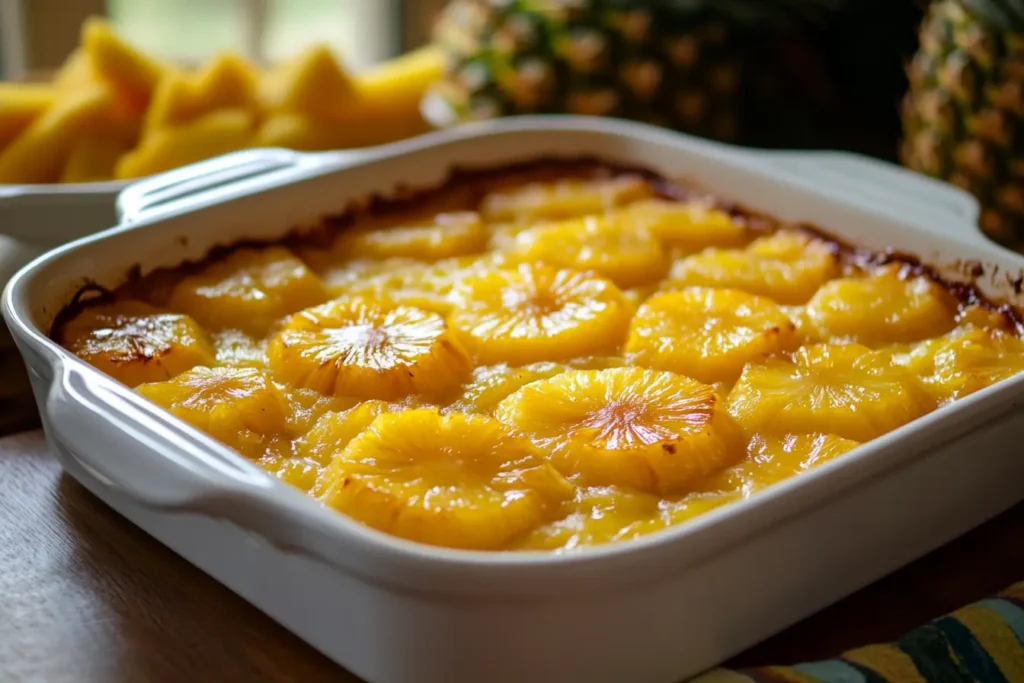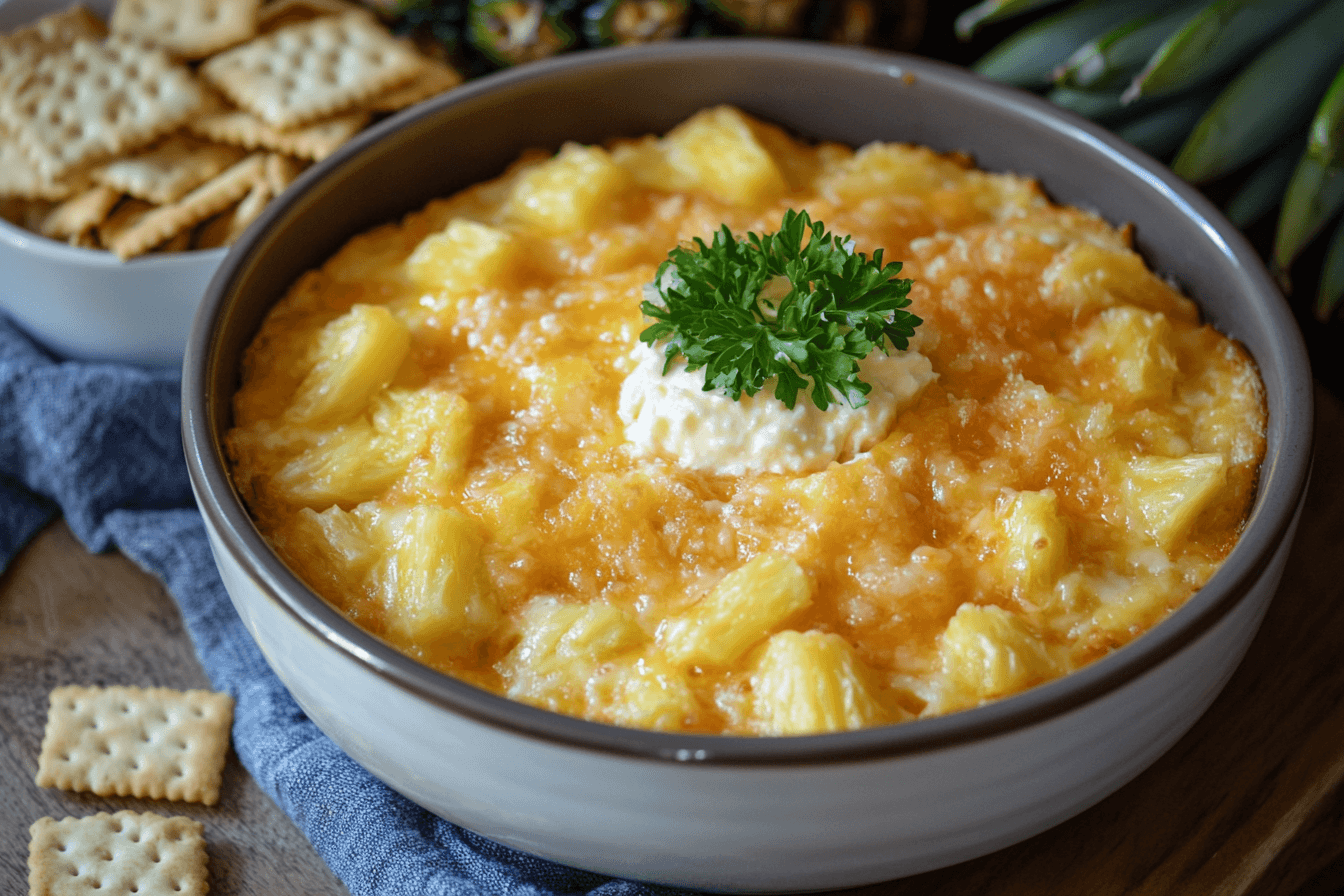Few dishes can claim to bridge the gap between sweet and savory as beautifully as pineapple casserole. This Southern classic is a beloved staple in many households, cherished for its unexpected yet harmonious combination of flavors. Combining the tropical sweetness of pineapple with the buttery crunch of crackers and the richness of cheddar cheese, it’s no surprise that this dish has won the hearts of food lovers everywhere. Its unique flavor profile is intriguing and universally appealing, making it a conversation starter at any meal.
Pineapple casserole embodies the charm of comfort food with a twist, whether served as a side dish, dessert, or even the centerpiece of a holiday meal. Its allure comes from its simplicity, adaptability, and the happiness it adds to any table. More than just a recipe, it’s a testament to the creative spirit of Southern cuisine, where tradition meets innovation in every bite. Let’s dive into what makes this dish a standout.
Table of Contents
The Origins and History
The origins of pineapple casserole are deeply rooted in Southern cuisine, where bold flavors and creative combinations reign supreme. Pineapples, once considered an exotic delicacy, became more widely accessible in the United States during the mid-20th century thanks to advancements in canning and transportation. Southern cooks, known for their ingenuity, quickly found ways to incorporate this tropical fruit into their recipes.
Traditionally, pineapple casserole was a holiday dish, gracing tables during Easter, Thanksgiving, and Christmas feasts. Its unique blend of sweet and savory made it the perfect accompaniment to rich roasts and savory sides. Over the years, the recipe has seen countless adaptations, with some adding spices like cinnamon or nutmeg while others experiment with toppings such as pecans or brown sugar. Today, pineapple casserole remains a symbol of culinary creativity and a testament to the joy of unexpected flavor pairings.
For those interested in how different cultures adapt holiday recipes, check out this guide to Christmas bark, another beloved festive dessert.
Essential Ingredients
The magic of pineapple casserole lies in its simplicity. Here’s a breakdown of the essential ingredients and their roles:
- Pineapple (canned or fresh): The star of the dish, providing a burst of sweetness and juiciness. Canned pineapple chunks or crushed pineapple are commonly used for convenience, but fresh pineapple can be a delightful upgrade.
- Cheddar Cheese: Adds a savory, tangy contrast to the sweetness of the pineapple. Opt for sharp cheddar for maximum flavor.
- Butter: Enhances the richness of the dish and helps bind the topping.
- Crackers (e.g., Ritz): Crushed crackers create a buttery, crunchy topping that complements the pineapple’s soft texture. For a gluten-free option, substitute with gluten-free crackers or crushed nuts.
- Sugar: Balances the tanginess of the pineapple and cheese, creating a harmonious blend of flavors.
- Flour: Thick the casserole’s base, ensuring a cohesive texture.
Optional ingredients include:
- Brown Sugar: For a deeper sweetness in the topping.
- Pecans: For added crunch and a nutty flavor.
- Spices: Cinnamon or nutmeg can provide a warm, aromatic touch.
Tips and Tricks for Perfect Pineapple Casserole
Creating the perfect pineapple casserole doesn’t have to be daunting. Here are some helpful tips and tricks to ensure success every time:
- Drain Thoroughly: Always drain the pineapple thoroughly to prevent the casserole from becoming too watery. If you’re using fresh pineapple, pat it dry with a paper towel after cutting.
- Use Sharp Cheddar: Opt for sharp cheddar cheese for a pronounced savory contrast to the sweetness of the pineapple.
- Preheat the Oven: Ensure the oven is fully preheated before placing the casserole inside. This helps the topping bake evenly.
- Layer Evenly: Spread each layer evenly in the baking dish to ensure a balanced combination of flavors in every bite.
- Customize the Sweetness: Adjust the sugar according to your taste preferences. You can reduce the sugar for a more savory version or add a touch more for a dessert-like experience.
- Crisp the Topping: For an extra crispy topping, broil the casserole for the last 1-2 minutes of baking, but keep a close eye to avoid burning.
- Experiment with Add-Ins: Don’t be afraid to add nuts, shredded coconut, or even a pinch of cinnamon to enhance the flavor and texture.
Step-by-Step Instructions
Follow these steps to create a perfect pineapple casserole:
- Preheat the oven to 350°F (175°C). This ensures even cooking and a golden, bubbly top.
- Prepare the Pineapple Base: Drain two cans of pineapple chunks or crushed pineapple, reserving 1/4 cup of the juice, and mix them with 1/2 cup of sugar and 2 tablespoons of flour until evenly coated in a large bowl.
- Layer the ingredients: Spread the pineapple mixture evenly in a greased 9×13-inch baking dish.
- Add the cheese: Sprinkle 1 to 1.5 cups of shredded cheddar cheese over the pineapple layer.
- Make the Topping: Mix 4 cups of melted butter, 1 cup of crushed crackers, and 1 cup of brown sugar (optional) in a bowl until evenly coated.
- Assemble the casserole: Evenly spread the topping over the cheese layer.
- Bake: Place the casserole in the preheated oven and bake for 25-30 minutes until the topping is golden brown and the edges are bubbly.
- Cool slightly before serving: This allows the flavors to meld and makes it easier to scoop out portions.
Pro Tip: To achieve an extra crispy topping, broil the casserole for 1–2 minutes at the end of baking. Keep a close watch to prevent burning.
Variations and Customizations
One of the joys of pineapple casserole is its adaptability. Here are some creative twists to suit different tastes and dietary needs:
- Gluten-Free Option: Replace crackers with crushed gluten-free crackers or cornflakes.
- Low-Sugar Version: Use a natural sweetener like honey or maple syrup instead of granulated sugar.
Nutty Twist: Top with a layer of chopped walnuts or pecans to add a satisfying crunch and a burst of nutty flavor.
- Spiced Version: For a warm, aromatic flavor, incorporate a pinch of cinnamon, nutmeg, or even a dash of ginger.
- Savory Focus: Reduce the sugar and add a pinch of salt and pepper to emphasize the savory elements.
- Vegan Adaptation: Use dairy-free cheddar-style cheese, plant-based butter, and a vegan-friendly sweetener.
For more creative variations of classic recipes, check out this guide to eggplant casseroles, highlighting traditional dishes’ flexibility.
Serving Suggestions
Pineapple casserole is a dish that complements a range of mains and sides. Here are some ideas to inspire a memorable meal:
- Grilled Chicken: A lighter protein option that balances the richness of the casserole.
- Roasted Vegetables: Try a medley of carrots, parsnips, and brussels sprouts for a colorful and nutritious side.
- Garlic Bread: Perfect for scooping up every last bit of the casserole.
- Mixed Green Salad: A refreshing contrast to the richness of the dish, especially when dressed with a tangy vinaigrette.
- Sparkling Beverages: Serve with a chilled glass of sparkling water, white wine, or even a light prosecco for a festive touch.
Nutritional Benefits
While pineapple casserole is undoubtedly indulgent, it also offers some nutritional perks:
- Pineapple: This tropical fruit is an excellent source of vitamin C, which boosts immunity, and manganese, which supports bone health and metabolism. Pineapple also contains bromelain, an enzyme that aids in digestion and reduces inflammation.
- Cheddar Cheese: A rich source of calcium for strong bones and teeth, along with protein to aid muscle repair and growth. It also provides essential vitamins like B12, which play a key role in red blood cell production.
- Butter: While often regarded as a treat ingredient, butter, in moderation, supplies vitamin A, supporting eye health and immune function.
- Crackers: These contribute carbohydrates, which are the body’s primary energy source. Opting for whole-grain or enriched crackers can provide additional fiber and nutrients like iron and B vitamins.
- Balanced Energy: The combination of fats, proteins, and carbohydrates in the casserole makes it a satisfying dish that provides sustained energy.
If you want to make the dish healthier, consider reducing the added sugar, substituting crackers with high-fiber options, or incorporating nuts for healthy fats. By tailoring the recipe to your needs, you can enjoy a flavorful dish that also provides essential nutrients.

Common Mistakes to Avoid
Even a simple dish like pineapple casserole has its pitfalls. Here’s how to sidestep them:
- Overloading the Topping: Too much topping can overwhelm the balance of flavors. Stick to the recommended ratio.
- Skipping the Drain Step: Excess pineapple juice can make the casserole watery. Always drain the pineapple thoroughly.
- Overmixing the Topping: This can create a soggy texture. Gently combine the topping ingredients for the best results.
- Burning the Top: If broiling, watch carefully to prevent the topping from burning.
- Underbaking: Ensure the casserole bakes long enough for the flavors to meld and the topping to crisp.
Frequently Asked Questions
Q: Can I make pineapple casserole ahead of time?
A: Of course! Prepare the casserole up to the baking step and cover it tightly, and refrigerate for up to 24 hours. When ready to bake, add a few extra minutes to the cooking time.
Q: How do I store leftovers?
A: Leftovers can be kept in an airtight container in the refrigerator for up to 3 days. Reheat using the oven or microwave until thoroughly warmed.
Q: Can I freeze pineapple casserole?
A: Yes, but note that the texture of the topping may change slightly. To freeze, assemble the casserole without baking, wrap tightly, and freeze for up to 2 months. Thaw in the refrigerator before baking.
Q: What substitutions work for a healthier version?
A: Use less sugar, opt for whole-grain crackers, and experiment with dairy-free or low-fat cheese.
Q: Is pineapple casserole gluten-free?
A: It can be! Substitute the crackers with gluten-free options or crushed nuts.
Conclusion
Pineapple casserole is more than just a dish; it’s an experience. Its delightful interplay of sweet and savory flavors makes it a standout addition to any table. Whether you’re introducing it to friends for the first time or rekindling fond memories of family gatherings, this dish is sure to impress. Its versatility ensures it can shine as a side dish, a dessert, or even the meal’s star.
What makes pineapple casserole truly special is its ability to allow for personal expression. Whether you follow the classic recipe or explore unique twists, every preparation brings its own story to the table. It’s a reminder that great food isn’t just about taste—it’s about connection, comfort, and joy.
So why not give it a try? Gather your ingredients, preheat the oven, and embrace the magic of this Southern classic. Once you take that first bite, you’ll understand why pineapple casserole has stood the test of time as a beloved staple. Happy cooking and even happier eating!

